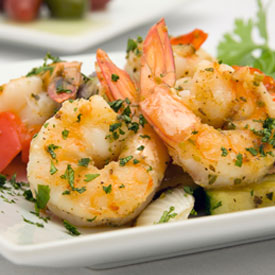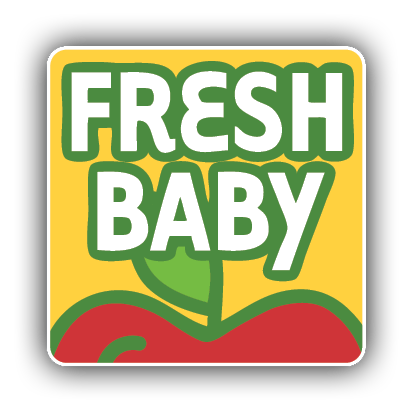
According to the food historians, both ancient Romans and Greeks enjoyed their shrimp – roasted over coals, glazed with honey, wrapped in fig leaves and prepared many other ways. Marco Polo also discovered that shrimp was also a major staple for the Chinese
Interestingly, the “shrimp cocktail,” is uniquely an American recipe calling for Tabasco sauce, a Louisiana invention. Developed in the early 1920’s, the decade of Prohibition, “cocktail” appetizers, such as shrimp cocktail were extremely popular. These appetizers were served in “cocktail glasses” originally meant for alcoholic beverages – quite an innovative use of stemware!
The word shrimp comes from the Middle English shrimpe, meaning “pygmy”. While shrimp may be small, they are anything but shrimp-y in their nutrition profile. Low in calories and saturated fat, shrimp are a wonderfully nutritious alternative to meat proteins. Shrimp also offers beneficial doses of omega-3 fatty acids which improve heart health, offer protection against Alzheimer’s, and may improve mood and reduce depression. Shrimp also provides great sources of vitamins and minerals including vitamin B12, niacin, iron, selenium, zinc and copper.
A great nutrition profile, a rich American culinary history, and the #1 favorite seafood in the USA. Mmmmm. We’re getting hungry!
Age to introduce: 2-3 years old. Shrimp are a choking hazard for small children.
CAUTION Allergy: Shrimp and other shellfish are considered a common allergen.
Kid-Friendly Treat: Crispy Coconutty Shrimp
The tropical sweetness of coconut combined with shrimp is a true winner. Served in many restaurants, coconut shrimp are often deep fried arriving at your table dripping with unhealthy amounts of fat. This variation uses less oil, delivers a crispy texture and restaurant quality flavor!
Make it fun – Get your kids involved in the prep. In this recipe, you’ll set up three dipping stations – the dredge, the liquid and the crunch. The dipping steps are perfect tasks for little fingers (and your fingers will stay clean for cooking). Plus their “I helped Mom make dinner” pride will likely win over even the pickiest eater.
Ingredients:
- 12-15 large shrimp, shelled and de-veined
- ¼ cup cornstarch
- ½ tsp. salt
- ½ cup coconut milk
- ¾ cup panko crumbs*
- ¾ cup unsweetened shredded coconut**
- ¼ cup vegetable oil
- Sweet and sour sauce for dipping
* Panko crumbs are Japanese bread crumbs. They are often stocked in the Asian section of your supermarket.
** Unsweetened coconut is stocked in the bulk section of a natural foods store.
Directions:
Step 1: Set up the dipping station with three wide flat bowls. Place the corn starch and salt in first bowl and mix with a fork. Pour the coconut milk in the second bowl. Toss together the panko and coconut in the third bowl.
Step 2: Dredge the shrimp on both sides in the cornstarch. Then dip them into coconut milk and then coat them in the panko/coconut mixture, pressing lightly.
Step 3: Heat the oil in a large skillet over medium high. Fry shrimp until browned, about 2 minutes per side. Drain on a paper-towel lined platter. Serve with dipping sauce.
Dipping Sauce: Store bought sweet and sour sauce is perfect for this dish. If your kids would like a more familiar flavor; try mixing equal parts ketchup and sweet and sour sauce together.
Makes 4 servings.
Shrimp For The Family
At the market: Shrimp are available fresh or frozen, and cooked and uncooked. When buying uncooked, fresh shrimp avoid shells with black spots or ones that appear yellow or gritty. Shrimp will smell a little fishy, but a strong ammonia odor is not good.
Unless you live in the part of the country where you can actually buy “fresh” shrimp, it is best to buy frozen shrimp. Uncooked, frozen shrimp are often available with shells spilt and de-veined. This saves prep time and is convenient. Look for a “best by” date on the package and don’t purchase “expired” packages. Shrimp should be loose in the package – avoid a frozen block feel. This is a sign the package thawed and was re-frozen.
Whichever you choose – fresh or frozen, Shrimp come in a variety of sizes and they are priced accordingly. As a rule, the fewer number of shrimp in a pound, the more expensive. Bigger is not always the best when you’re cooking shrimp. Here are a few guidelines to selecting the right size shrimp for your family meals:
Adult only and special occasions:
10 shrimp or less = Colossal sometime called prawns
11 to 15 = Jumbo
Great for grilling, pan frying, and shrimp cocktail:
16 to 20 = Extra-large
21 to 30 = Large
Perfect for sauces, pasta dishes, and stir fries:
31 to 35 = Medium
Good for salads, soups and adding to dips:
36 to 45 = Small
over 100 = miniature
Storage: Fresh: Fresh shrimp is highly perishable, refrigerate on the bottom shelf, which is the coolest area of the fridge until ready to use. Fresh shrimp should eaten within 24 hours of purchase.
Frozen: Use frozen shrimp within 6 month of purchase or before the “best by” date on the package. Follow package instructions to defrost shrimp.
Preparation: Overcooked shrimp are tough and rubbery. The key to cooking shrimp, regardless of method, is to cook them quickly. Medium shrimp only take about 2 minutes to cook; larger shrimp take 3 to 5 minutes. When they’re pink, they are done.
Creative and simple ideas to include Shrimp into your family meals:
Shrimp on the Barbie: Grilled shrimp could not be easier or quicker to prepare. Threading shrimp on bamboo skewers makes them easy to turn over. Peel, devein, and rinse the shrimp, Sprinkle with salt and pepper, thread on skewers and cook about 1-2 minutes on each side. Just before removing from the grill, baste the shrimp with a sauce such as:
- Barbeque Sauce
- Teriyaki Glaze
- Italian Salad Dressing
- Thai Peanut Sauce
- Garlic Butter
Southwestern Shrimp Cocktail: If you need to bring a simple appetizer to a pot luck dinner. Defrost a bag of medium or large cooked shrimp, arrange them on a platter and serve with salsa for dipping.
“Sketti & Shrimp”: Make a quick, easy and healthy pasta dish by adding cooked shrimp to pasta sauce and serve over angel hair pasta. They’ll be begging for second helpings!
Taste of the Tropics: Shrimp and Mango are a natural flavor combination. For a refreshing lunch or light dinner, simply toss diced mango with cooked shrimp and this tropical coconut dressing (whisk the ingredients together before tossing) :
- ¼ cup sweetened shredded coconut
- 2 Tbsp chopped cilantro
- 1 inch minced fresh ginger
- 1 tsp minced garlic clove
- 1/2 tsp sea salt
- 2 Tbsp fresh lime juice
- 1/4 cup olive oil
Time Saver Tip: Frozen Cooked Shrimp are good for more than shrimp cocktail or cold salads. They can be warmed up and used in hot meals. This can save you time in the kitchen. Defrost cooked shrimp according to the package directions. A couple minutes before a dish is taken off the stove, add shrimp and let them warm through. This works for:
- Soups
- Fried Rice
- Pasta
- Stir Fries
Restaurant-Style Scampi: Shrimp Scampi is a very popular Italian dish containing a few basic, fresh ingredients that blend together in delicious harmony. Scampi in restaurants can carry a heft price tag. Making it at home is very affordable – this recipe uses medium-sized shrimp which are often on sale too.
- 1 lb medium shrimp- shelled and de-veined
- 3 cloves garlic, pressed
- 1 Tbsp olive oil
- 1 cup dry white wine
- 1 Tbsp fresh or 1 tsp dried Italian herb blend
- 2 tsp corn starch
- 1 tsp cold water
Directions: Heat oil in non-stick skillet over med-high heat. Add garlic and stir constantly for 30 seconds. Add shrimp. Sauté for 3 minutes stirring occasionally. Add wine and herbs, cook for 1 minute. Mix water and corn starch together and add to the juice in the pan while stirring. Once sauce has thickened dish is done, serve hot over pasta or brown rice.


